Almoravid Works on Defensive Architecture in Southeast Al-Andalus: Analysis of Their Remains and Proposal for Preventive Conservation
Abstract
1. Introduction
2. Objectives and Methodological Approach
- To approach the historical-artistic analysis of the Almoravid works in the six preselected constructions.
- To analyse the types of risks that have affected these constructions since medieval times.
- To specify the pathologies that affect these assets.
- To propose a systematic preventive conservation and maintenance method based on the developed analysis for the two following cases of study: the walls of the Alcazaba Qadīma (Granada) and the walls of La Hoya and Cerro de San Cristóbal (Almeria).
3. Reforms in the Military Constructions in Granada and Almeria (First Half of the 12th Century)
3.1. Granada: Almoravid Capital of Al-Andalus
3.1.1. Walls of the Alcazaba Qadīma
Historical Approach
Architectural Form
Building Structure and Materials
Anthropic Risks
Natural Risks
Conservation Status
3.1.2. Walls of the Alcazaba of Guadix
Historical Approach
Architectural Form
Building Structure and Materials
Historical Risks
Anthropic Risks
Natural Risks
Conservation Status
3.2. Almeria and Its Port in the First Half of the 12th Century
3.2.1. Walls of La Hoya and Cerro de San Cristóbal
Historical Approach
Architectural Form
Building Structure, Materials and Topography
Historical Risks
Anthropic Risks
Natural Risks
Conservation Status
3.2.2. Urban Wall of Almeria
Historical Approach
Architectural Form
Building Structure and Materials
Historical Anthropic Risks
Historical Natural Risks
Conservation Status
3.2.3. El Castillejo Castle, Abrucena
Historical Approach
Architectural Form
Building Structure and Materials
Anthropic Risks
Natural Risks
Conservation Status
3.2.4. The Castle of Bacares
Historical Approach
Architectural Form
Building Structure and Materials
Historical Risks
Anthropic Risks
Natural Risks
Conservation Status
4. Synthesis of the Results
5. Discussion: Proposal of a Preventive Conservation Method for Two Case Studies
5.1. Systematic Measures for the Walls of the Alcazaba Qadīma (Granada)
- Cleaning and clearing of vegetation in the environment of the wall.
- Manual removal of invasive vegetation that could be deposited on the wall, having previously applied non-aggressive herbicides on the rammed-earth walls.
- Spraying most disintegrated surfaces of the walls with lime water.
- Brushing the upper part of the walls in order to eliminate earth deposits.
- To the above-mentioned measures, the following must be added:
- If necessary, and as determined by annual checks, conducting chemical laboratory tests that can determine the condition of the material stability of each section of the wall.
- The annual control of the structural stability systems of the walls, both their foundation and the structure itself.
- Revising the catalogue of elements every ten years in order to detect possible punctual disappearances of sections of the wall and the incorporation of new sections.
- Increasing public awareness, so that the local population can gain suitable knowledge of the presence and condition of the walls and be the first to collaborate in the inspection and control processes in order to detect problems that arise during the conservation.
5.2. Systematic Measures for the Wall of La Hoya and Cerro de San Cristóbal
6. Final Remarks
Author Contributions
Funding
Acknowledgments
Conflicts of Interest
References
- Ibn ‘Idhārī. Al-Bayān al-Mugrib, Nuevos Fragmentos Almorávides y Almohades; Huici Miranda, A., Translator; Gráficas Bautista: Valencia, Spain, 1963. [Google Scholar]
- Ibn Simāk. Al-Ḥulal al-Mawšiyya, Crónica Árabe de las Dinastías Almorávide, Almohade y Benimerín; Huici Miranda, A., Translator; Editorial Marroquí: Tetuán, Morocco, 1951. [Google Scholar]
- Villalba Sola, D. La Senda de los Almohades: Arquitectura y Patrimonio; Universidad de Granada—Casa Árabe Madrid: Granada, Spain, 2015. [Google Scholar]
- Marcos Cobaleda, M. En torno al arte y la arquitectura almorávides: Contribuciones y nuevas perspectivas. In Al-Murābiṭūn (los Almorávides): Un Imperio Islámico Occidental. Estudios en Memoria del Profesor Henri Terrasse; Marcos Cobaleda, M., Ed.; Patronato de la Alhambra y Generalife: Granada, Spain, 2018; pp. 314–344. [Google Scholar]
- Plan Para la Arquitectura Defensiva en Andalucía. Consejería de Cultura/Junta de Andalucía. 2004. Available online: https://www.juntadeandalucia.es/export/drupaljda/PADA_Lineas_generales.PDF (accessed on 19 November 2021).
- Plan Nacional de Arquitectura Defensiva. MECD. 2006. Available online: http://ipce.mcu.es/conservacion/planesnacionales/defensiva.html (accessed on 25 February 2019).
- Glasgow Climate Change Conference. 2021. Available online: https://unfccc.int/conference/glasgow-climate-change-conference-october-november-2021 (accessed on 19 November 2021).
- UNESCO. Climate Change and World Heritage Report on Predicting and Managing the Impacts of Climate Change on World Heritage and Strategy to Assist States Parties to Implement Appropriate Management Responses; UNESCO World Heritage Centre: Paris, France, 2007. [Google Scholar]
- ICOMOS Climate Change and Heritage Working Group. The Future of Our Pasts: Engaging Cultural Heritage in Climate Action; International Council on Monuments and Sites: Paris, France, 2019. [Google Scholar]
- Marrion, C. More effectively addressing fire/disaster challenges to protect our cultural heritage. J. Cult. Herit. 2016, 20, 746–749. [Google Scholar] [CrossRef]
- Ortiz, R.; Ortiz, P.; Martin, J.M.; Vázquez, M.A. A new approach to the assessment of flooding and dampness hazards in cultural heritage, applied to the historic centre of Seville (Spain). Sci. Total Environ. 2016, 551-552, 546–555. [Google Scholar] [CrossRef]
- Domínguez Ruiz, V. Aplicación de los Sistemas de Información Geográfica (SIG) al Proyecto de Rehabilitación Arquitectónica y Urbana. Ph.D. Thesis, University of Seville, Sevilla, Spain, 2016. [Google Scholar]
- CHANGES. Innovative Built Heritage Models—Edited Contributions to the International Conference on Innovative Built Heritage Models and Preventive Systems; CRC Press: Boca Raton, FL, USA, 2018. [Google Scholar]
- Quesada-Ganuza, L.; Garmendia, L.; Roji, E.; Gandini, A. Do we know how urban heritage is being endangered by climate change? A systematic and critical review. Int. J. Disaster Risk Reduct. 2021, 65, 102551. [Google Scholar] [CrossRef]
- Gobierno de España. Decreto de 22 de Abril de 1949 Sobre Protección de los Castillos Españoles; Boletín Oficial del Estado (BOE): Madrid, Spain, 1949. [Google Scholar]
- Gobierno de España. Ley 16/1985, de 25 de Junio, del Patrimonio Histórico Español; Boletín Oficial del Estado (BOE): Madrid, Spain, 1985. [Google Scholar]
- Korro Bañuelos, J.; Rodríguez Miranda, Á.; Valle-Melón, J.M.; Zornoza-Indart, A.; Castellano Román, M.; Angulo-Fornos, R.; Pinto-Puerto, F.; Acosta Ibáñez, P.; Ferreira-Lopes, P. The Role of Information Management for the Sustainable Conservation of Cultural Heritage. Sustainability 2021, 13, 4325. [Google Scholar] [CrossRef]
- Orihuela, A.; Molina-Fajardo, M.A. UAV Photogrammetry Surveying for Sustainable Conservation: The Case of Mondújar Castle (Granada, Spain). Sustainability 2021, 13, 24. [Google Scholar] [CrossRef]
- Benavides López, J.A.; Martín Civantos, J.M.; Rouco Collazo, J. Levantamiento arquitectónico y análisis arqueológico del Castillo de Píñar como punto de partida para su conservación. Virtual Archaeol. Rev. 2020, 11, 95–115. [Google Scholar] [CrossRef]
- Saha, A.; Pal, S.C.; Santosh, M.; Janizadeh, S.; Chowdhuri, I.; Norouzi, A.; Roy, P.; Chakrabortty, R. Modelling multi-hazard threats to cultural heritage sites and environmental sustainability: The present and future scenarios. J. Clean. Prod. 2021, 320, 128113. [Google Scholar] [CrossRef]
- Ortiz Calderón, P.; Pinto Puerto, F.; Verhagen, P.; Prieto, A. (Eds.) Science and Digital Technology for Cultural Heritage—Interdisciplinary Approach to Diagnosis, Vulnerability, Risk Assessment and Graphic Information Models; CRC Press/Balkema Taylor & Francis: Leiden, The Netherlands, 2020; Available online: https://online.vitalsource.com/#/books/9781000026528/cfi/6!/4/4@0.00:37.8 (accessed on 19 November 2021).
- Garrido, J.; Gutiérrez-Carrillo, M.L. Andalusian cultural heritage and natural hazards prevention. In Engineering Geology for Society and Territory: Preservation of Cultural Heritage; Lollino, G., Giordan, D., Marunteanu, C., Christaras, B., Yoshinori, I., Margottini, C., Eds.; Springer International Publishing: Cham, Switzerland, 2015; Volume 8, pp. 437–440. [Google Scholar] [CrossRef]
- Cristi Nicu, I. Natural risk assessment and mitigation of cultural heritage sites in North-eastern Romania (Valea Oii river basin). Area 2019, 51, 142–154. [Google Scholar] [CrossRef]
- Goded, T.; Irizarry, J.; Buforn, E. Vulnerability and risk analysis of monuments in Málaga city’s historical centre (Southern Spain). Bull. Earthq. Eng. 2012, 10, 839–861. [Google Scholar] [CrossRef]
- Salcedo Hernández, J.C.; Campesino Fernández, A.J. Experiencias constructivas del terremoto de Lorca. Investig. Geográficas 2012, 57, 7–37. [Google Scholar] [CrossRef][Green Version]
- Feriche, M.; Vidal, F.; Alguacil, G.; Aranda, C.; Pérez-Muelas, J.; Navarro, M.; Lemme, A. Performance of cultural heritage of Lorca (Spain) during the two small earthquakes of May 11th, 2011. In Proceeding of the 15th World Conference on Earthquake Engineering, Lisbon, Portugal, 24–28 September 2012. [Google Scholar]
- Justo, J.L.; Azañón, J.M.; Azor, A.; Saura, J.; Durand, P.; Villalobos, M.; Morales, A.; Justo, E. Neotectonics and slope stabilization at the Alhambra, Granada, Spain. Eng. Geol. 2008, 100, 101–119. [Google Scholar] [CrossRef]
- Cuéllar Mirasol, V. Trabajos realizados y coordinados por el centro de estudios y experimentación de obras Públicas. Cuad. Alhambra 1997, 33–34, 9–16. [Google Scholar]
- Plan Nacional de Emergencias y Gestión de Riesgos del Patrimonio Cultural. MECD. 2015. Available online: http://www.Mecd.Gob.Es/Planes-Nacionales/Planes/Emergencias.Html (accessed on 25 February 2019).
- Gurriarán Daza, P. Las técnicas constructivas en las fortificaciones andalusíes. In Arqueología Medieval: La Ciutat; Curull, F.S.i., Brufal, J., Eds.; Pagés Editors: Lleida, Spain, 2014; pp. 299–328. [Google Scholar]
- Gattuso, C.; Fernandez, F.; Marafon Pecoraro, M.; Palermo, A.M. Diagnostics for the knowlwdge: The case of the tower palazzo Termine Pietragliata in Palermo (Italy). In Defensive Architecture of the Mediterranean. XV to XVIII Centuries. Vol. II; Rodríguez-Navarro, P., Ed.; Universidad Politécnica: Valencia, Spain, 2015; pp. 389–396. [Google Scholar]
- Abderrahim-Mahindad, N. A monographic study of the military forts of the city of Bejaia and an analysis of their building systems. In Defensive Architecture of the Mediterranean. XV to XVIII centuries. Vol. V; Iribarren, E., Ed.; Publicacions Universitat: Alicante, Spain, 2017; pp. 359–366. [Google Scholar]
- Columbu, S.; Meloni, P. Alteration processes of geomaterials used on the pentagonal tower of Serravalle Castle (central-west Sardinia, Italy). In Defensive Architecture of the Mediterranean. XV to XVIII Centuries. Vol. II; Navarro, R., Ed.; Universidad Politécnica: Valencia, Spain, 2015; pp. 373–380. [Google Scholar]
- Gattuso, C.; Gattuso, P.; Bencardino, E. The Belvedere Marittimo Castle in Calabria-Italia: Materials and biological degradation. In Defensive Architecture of the Mediterranean. XV to XVIII Centuries. Vol. V; Iribarren, E., Ed.; Publicacions Universitat: Alicante, Spain, 2017; pp. 381–386. [Google Scholar]
- Mileto, C.; Vegas, F. (Eds.) La Restauración de la Tapia en la Península Ibérica. Criterios, Técnicas, Resultados y Perspectivas; Argumentum/TC Cuadernos: Valencia, Spain, 2014. [Google Scholar]
- Mileto, C.; Vegas, F.; García-Soriano, L.; Cristini, V. (Eds.) Vernacular and Earthen Architecture. Conservation and Sustainability; Balkema-Taylor & Francis: Amsterdam, The Netherlands, 2018. [Google Scholar]
- Ley de Patrimonio Histórico de Andalucía, 14/2007 de 26 de Noviembre. 2007. Available online: https://www.juntadeandalucia.es/boja/2007/248/1 (accessed on 19 November 2021).
- ICOM. Vantaa Resolution. Towards a European Strategy on Preventive Conservation; ICOM: Paris, France, 2000. [Google Scholar]
- Plan Nacional para la Conservación Preventiva. MECD. 2011. Available online: http://ipce.mcu.es/conservacion/planesnacionales/preventiva.html (accessed on 19 November 2021).
- Fregonese, L.; Rosina, E.; Adami, A.; Bottacchi, M.C.; Romoli, E.; Lattanzi, D. Monitoring as strategy for planned conservation: The case of Sant’Andrea in Mantova (Mantua). Appl. Geomat. 2018, 10, 441–451. [Google Scholar] [CrossRef]
- Chiessi, V.; D’Orefice, M.; Scarascia Mugnozza, G.; Vitale, V.; Cannese, C. Geological, geomechanical and geostatistical assessment of rockfall hazard in San Quirico Village (Abruzzo, Italy). Geomorphology 2010, 119, 147–161. [Google Scholar] [CrossRef]
- Bolteanu, D.; Chende, V.; Sima, M.; Enciu, P. A country-wide spatial assessment of landslide susceptibility in Romania. Geomorphology 2010, 124, 102–112. [Google Scholar] [CrossRef]
- Howey, M.C.L.; Burga, M.B. Assessing the state of archaeological GIS research: Unbinding analyses of past landscapes. J. Archaeol. Sci. 2017, 84, 1–9. [Google Scholar] [CrossRef]
- Gutiérrez-Carrillo, M.L.; Arizzi, A. How to deal with the conservation of the archaeological remains of earthen defensive architecture: The case of Southeast Spain. Archaeol. Anthropol. Sci. 2021, 13, 131. [Google Scholar] [CrossRef]
- Asprone, D.; Jalayer, F.; Prota, A.; Manfredi, G. Proposal of a probabilistic model for multi-hazard risk assessment of structures in seismic zones subjected to blast for the limit state of collapse. Struct. Saf. 2010, 32, 25–34. [Google Scholar] [CrossRef]
- Ortiz, R.; Macías-Bernal, J.M.; Ortiz, P. Vulnerability and buildings service life applied to preventive conservation in cultural heritage. Int. J. Disaster Resil. Built Environ. 2018, 9, 31–47. [Google Scholar] [CrossRef]
- Gutiérrez-Carrillo, M.L.; Bestué Cardiel, I.; Molero Melgarejo, E.; Marcos Cobaleda, M. Pathologic and Risk Analysis of the Lojuela Castle (Granada-Spain): Methodology and Preventive Conservation for Medieval Earthen Fortifications. Appl. Sci. 2020, 10, 6491. [Google Scholar] [CrossRef]
- TARMA Restauración y Patrimonio. Caracterización de Materiales de las Obras de Restauración de las Murallas del Albaicín de Granada; Tarma Restauración y Patrimonio: Granada, Spain, 2017; unpublished work. [Google Scholar]
- TARMA Restauración y Patrimonio. Caracterización de Materiales de las Obras de Restauración de Puerta de Hernán Román, nº 9 del Callejón de San Cecilio; Tarma Restauración y Patrimonio: Granada, Spain, 2017; unpublished work. [Google Scholar]
- Tesela, S.L. Informe Técnico-Científico. Análisis de Materiales de Construcción Procedentes de Fortificaciones de Tierra en las Provincias de Almería y Murcia (Proyecto PREFORTI II); Tesela, SL: Granada, Spain, 2018; unpublished work. [Google Scholar]
- Marcos Cobaleda, M. Los Almorávides: Arquitectura de un Imperio; Universidad de Granada—Casa Árabe Madrid: Granada, Spain, 2015. [Google Scholar]
- Fernández-Puertas, A. La mezquita aljama de Granada. In Miscelánea de Estudios Árabes y Hebraicos; Sección Árabe-Islam: Granada, Spain, 2004; Volume 53, pp. 39–76. [Google Scholar]
- Llanillo, A. Los almorávides. In Cuatro Temas de Historia Norteafricana; Facultad de Letras: Granada, Spain, 1955; pp. 53–99. [Google Scholar]
- López López, M. Excavaciones Arqueológicas en el Albayzín (Granada). II. Plaza de Santa Isabel la Real; Fundación Patrimonio Albayzín: Granada, Spain, 2001. [Google Scholar]
- Bestué Cardiel, I. Plan Director de las Murallas de la Alcazaba Cadima en el Albaicín (Granada); unpublished work.
- Alegre Aparicio, E. Intervención arqueológica preventiva en el parque lineal de la muralla zirí (Granada). In Anuario Arqueológico de Andalucía 2005; Granada; Consejería de Cultura Junta de Andalucía: Sevilla, Spain, 2010; pp. 1509–1518. [Google Scholar]
- Malpica Cuello, A. Granada, Ciudad Islámica. Mitos y Realidades; Asukaría Mediterránea: Granada, Spain, 1998. [Google Scholar]
- Pérez Asensio, M.; Sánchez Gómez, M. Informe Preliminar de la Actuación Arqueológica en las Obras de Emergencia en las Murallas de Granada. Callejón de San Cecilio nº 13–17, Albaizín, Granada; unpublished work.
- ‘Abd Allāh. El Siglo XI en Primera Persona. Las Memorias de ‘Abd Allāh, Último rey zirí de Granada Destronado por los Almorávides (1090); Leví-Provençal, É.; García Gómez, E., Translators; Alianza Editorial: Madrid, Spain, 2005. [Google Scholar]
- Raya de Cárdenas, I. Excavaciones arqueológicas en la Alcazaba de Guadix (Granada). In Anuario Arqueológico de Andalucía 1987; Consejería de Cultura Junta de Andalucía: Sevilla, Spain, 1991; pp. 134–138. [Google Scholar]
- Martín Civantos, J.M.; Ramírez Burgos, M.; Raya García, S.; Rotolo, A.S.F. Intervención Arqueológica Puntual de Apoyo a la Propuesta de Parque Arqueológico en la Alcazaba de Guadix (Granada); unpublished work.
- Martín Civantos, J.M. Informe Preliminar de la Intervención Arqueológica Puntual de Apoyo a la Propuesta de Parque Arqueológico en la Alcazaba de Guadix (Granada) Informe de Excavación; Junta de Andalucía; Consejería de Cultura: Granada, Spain, 2010. [Google Scholar]
- Bestué Cardiel, I. Alcazaba de Guadix. In Catálogo de Granada; Proyecto PREFORTI; unpublished work.
- Rouco Collazo, J. La alcazaba y la ciudad de Guadix (Granada). Perspectivas desde la Arqueología de la Arquitectura. In O Papel das Pequenas Cidades na Construção da Europa Medieval; Millán da Costa, A.A., Andrade, A., Tente, C., Eds.; Instituto de Estudos Medievais—Câmara Municipal de Castelo de Vide: Lisboa, Portugal, 2017; pp. 177–196. [Google Scholar]
- Martín Civantos, J.M.; Raya García, S. La alcazaba de Guadix: De fortaleza andalusí a cuartel militar napoleónico. Boletín Inst. Estud. Pedro Suárez 2009, 22, 283–296. [Google Scholar]
- Asenjo Sedano, C. Arquitectura Religiosa y Civil de la Ciudad de Guadix. Siglo XVI.; Universidad de Granada: Granada, Spain, 2000. [Google Scholar]
- Bestué Cardiel, I.; Cañones, C.; Carmona, R. Proyecto de Restauración del Recinto Inferior de la Alcazaba De Guadix; 2018; unpublished work.
- Al-Idrīsī. Descripción de España (obra del siglo XII). In Textos y Obras Clásicas Sobre la Presencia del Islam en la Historia de España; B. López García (compilator); Fundación histórica Tavera, MAPFRE: Madrid, Spain, 1998. [Google Scholar]
- Al-Ḥimyarī. La Péninsule Ibérique au Moyen Âge D’après le Kitāb Al-Rawḍ al-Mi‘ṭār fī jabar Al-Aqṭār d’Ibn ‘Abd Al-Mun‘im Al-Ḥimyarī; Lévi-Provençal, É., Translator; E. J. BRILL: Leyden, The Netherlands, 1938. [Google Scholar]
- Suárez Márquez, Á. Memoria de la excavación de urgencia realizada en el solar situado en la calle Reina, Parque Nicolás Salmerón (Almería). In Anuario Arqueológico de Andalucía 1985; Consejería de Cultura de la Junta de Andalucía: Sevilla, Spain, 1987; Volume III, pp. 22–28. [Google Scholar]
- Molina, E. Historia de una prosperidad quebrada. In La Alcazaba. Fragmentos Para una Historia de Almería; Suárez Márquez, Á., Ed.; Junta de Andalucía: Almería, Spain, 2005; pp. 15–41. [Google Scholar]
- Viguera Molins, M.J. El retroceso Territorial de al-Andalus: Almorávides y Almohades. Siglo XI al XIII. Vol. VIII** of Historia de España de Ramón Menéndez Pidal; Espasa-Calpe: Madrid, Spain, 1994–2000. [Google Scholar]
- Cara Barrionuevo, L. La Almería Islámica y su Alcazaba; Editorial Cajal: Almería, Spain, 1990. [Google Scholar]
- Espinosa Spínola, G.; Nicolás Martínez, M.d.M.; Torres Fernández, R.; Ureña Uceda, A. Guía Artística de Almería y su Provincia; Fundación José Manuel Lara/Diputación Provincial de Almería: Almería, Spain, 2006. [Google Scholar]
- GEOCISA. Estudio de la Estabilidad Estructural de los Muros y Forjados de la Muralla y Torreones del Cerro San Cristóbal. Almería; File B03-0172CA-04AL; Dirección General de Bienes Culturales y Museos: Sevilla, Spain, 2003. [Google Scholar]
- Basterra Pinilla, J. Proyecto Básico y de Ejecución Restauración de la Muralla de la Hoya, Almería; File B043185 HP04BC; Delegación de Cultura de Almería: Almería, Spain, 2006. [Google Scholar]
- Al-‘Udhrī. Fragmentos Geográfico-Históricos de “Masālik ilā Gamī al-Mamālik”, Critical ed.; ‘Abd al-‘Azīz al-Ahwānī; Institute of Islamic Studies: Cairo, Egypt, 1965. [Google Scholar]
- Gómez Muro, R.M. Excavación arqueológica de urgencia en Calle Antonio Vico, nº 26 y 28. In Anuario Arqueológico de Andalucía 2000; Consejería de Cultura de la Junta de Andalucía: Sevilla, Spain, 2003; Volume III-1, pp. 26–36. [Google Scholar]
- Alcaraz Hernández, F.M. Vigilancia arqueológica en el centro histórico de Almería. In Anuario Arqueológico de Andalucía 2000; Consejería de Cultura de la Junta de Andalucía: Sevilla, Spain, 2003; Volume III-1, pp. 13–16. [Google Scholar]
- IAPH. Restos de muralla urbana en calle Reina. In Base de Datos del Patrimonio Inmueble de Andalucía; IAPH—Consejería de Cultura de la Junta de Andalucía: Sevilla, Spain; Available online: http://www.iaph.es/patrimonio-inmueble-andalucia/resumen.do?id=i12285 (accessed on 14 June 2017).
- IAPH. Restos de muralla urbana en calle Inés Relaño. In Base de Datos del Patrimonio Inmueble de Andalucía; IAPH—Consejería de Cultura de la Junta de Andalucía: Sevilla, Spain; Available online: http://www.iaph.es/patrimonio-inmueble-andalucia/resumen.do?id=i8013 (accessed on 14 June 2017).
- López Guzmán, R. Arquitectura de al-Andalus (Almería, Granada, Jaén, Málaga); El Legado Andalusí—Comares: Granada, Spain, 2002. [Google Scholar]
- Gil Albarracín, A. Almería: La Plaza de Armas. Más de Mil Años de Fortificaciones; Griselda Bonet Girabet: Barcelona, Spain, 2014. [Google Scholar]
- Villalba Sola, D. Patrimonio Almohade: Conocimiento Histórico y Arquitectura. Ph.D. Thesis, University of Granada, Granada, Spain, 2013. [Google Scholar]
- Sánchez Barbero, I. Análisis Arqueológico y Constructivo de “El Castillejo” de Abrucena; Trabajo de Fin de Máster. Dir.: J. M. Martín Civantos; Universidad de Granada: Granada, Spain, 2010. [Google Scholar]
- Al-Idrīsī. Los Caminos de al-Andalus en el Siglo XII; Abid Mizal, J., Translator; CSIC—Instituto de Filología: Madrid, Spain, 1989. [Google Scholar]
- IAPHc. Castillo El Castillejo. In Base de Datos del Patrimonio Inmueble de Andalucía; IAPH—Consejería de Cultura de la Junta de Andalucía: Sevilla, Spain; Available online: http://www.iaph.es/patrimonio-inmueble-andalucia/resumen.do?id=i19612 (accessed on 14 June 2017).
- Castellón Sánchez del Pino, A. Castillos y Atalayas del Almanzora; Instituto de Estudios Almerienses: Almería, Spain, 2017. [Google Scholar]
- IAPHd. Castillo. In Base de Datos del Patrimonio Inmueble de Andalucía; IAPH/Consejería de Cultura de la Junta de Andalucía: Sevilla, Spain; Available online: http://www.iaph.es/patrimonio-inmueble-andalucia/resumen.do?id=i8084 (accessed on 14 June 2017).
- Cressier, P. Prospección arqueológica en la Sierra de los Filabres y Alto Valle del Almanzora. (Almería. 1985). In Anuario Arqueológico de Andalucía 1985; Consejería de Cultura de la Junta de Andalucía: Sevilla, Spain, 1987; pp. 71–80. [Google Scholar]
- García Ramírez, J.M. Proyecto Básico y de Ejecución de Restauración del Castillo de Bacares. Almería; File B051128HP04AL; Dirección General de Bienes Culturales y Museos: Sevilla, Spain, 2006. [Google Scholar]
- Diario de Almería. La Hoya Recupera las Raíces con un Parque Blando, de Acequias y Plantas Autóctonas. 14 June 2021. Available online: https://www.diariodealmeria.es/almeria/Hoya-parque-proyecto-Almeria_0_1583243156.html (accessed on 29 June 2021).
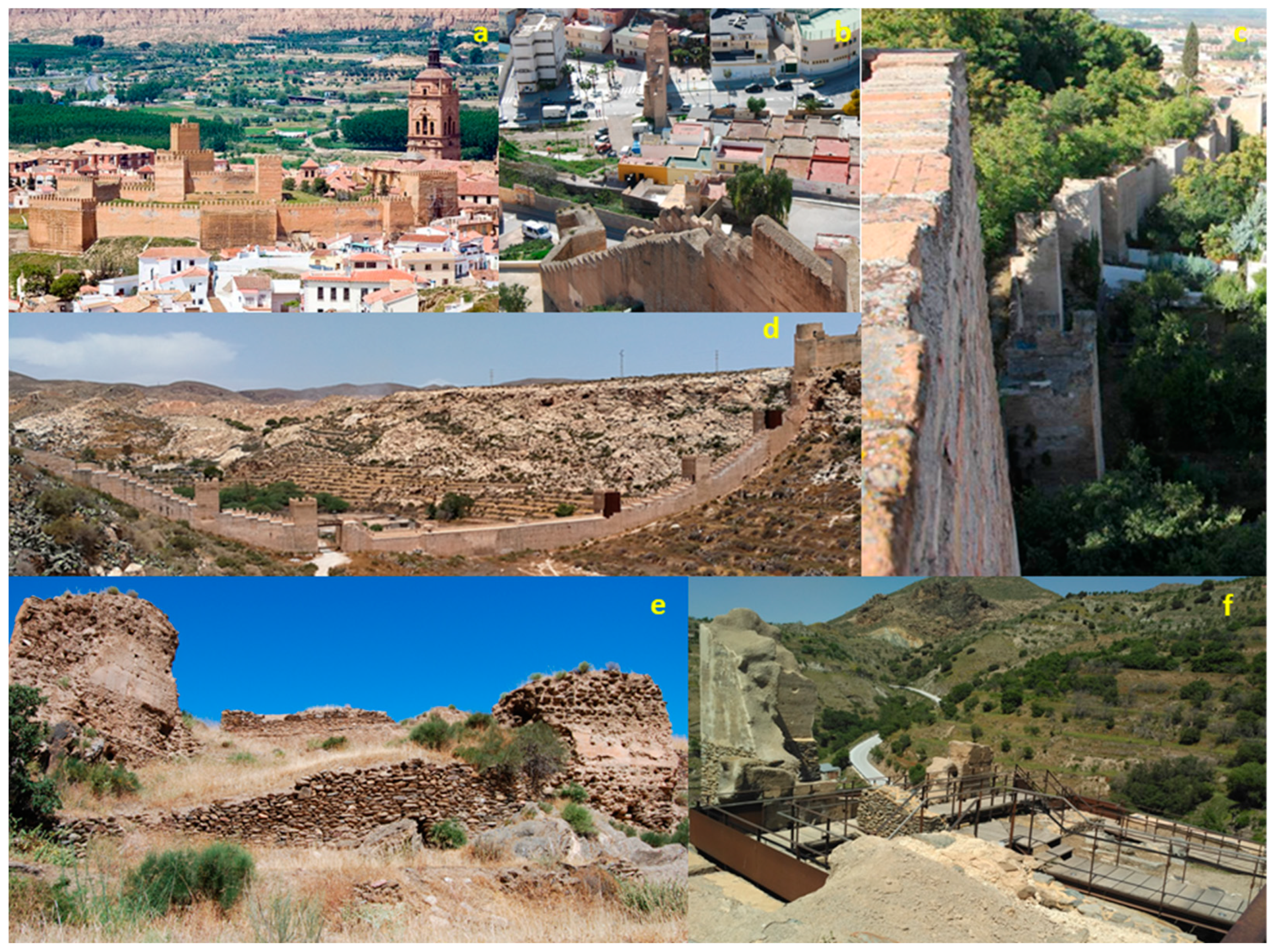
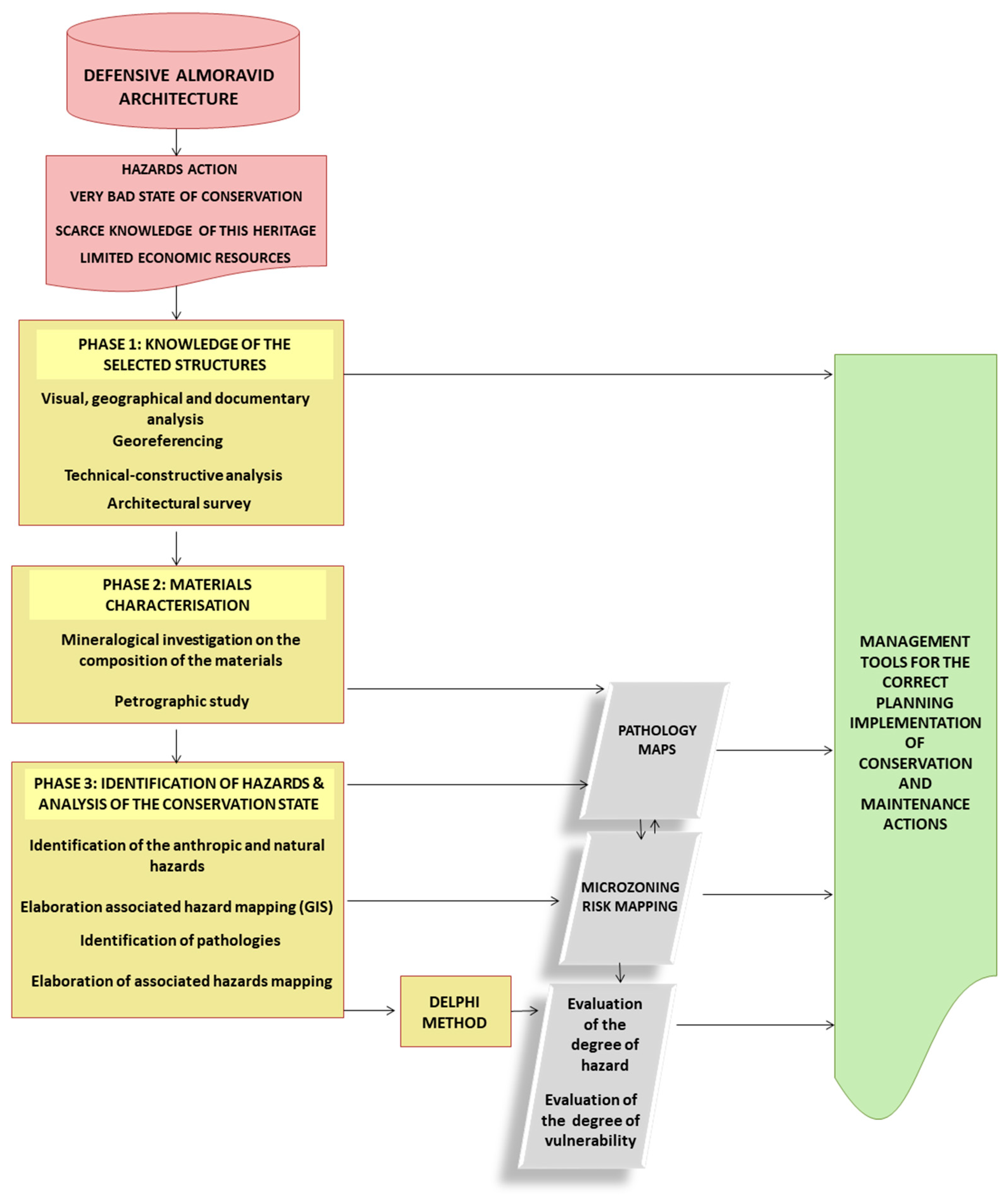

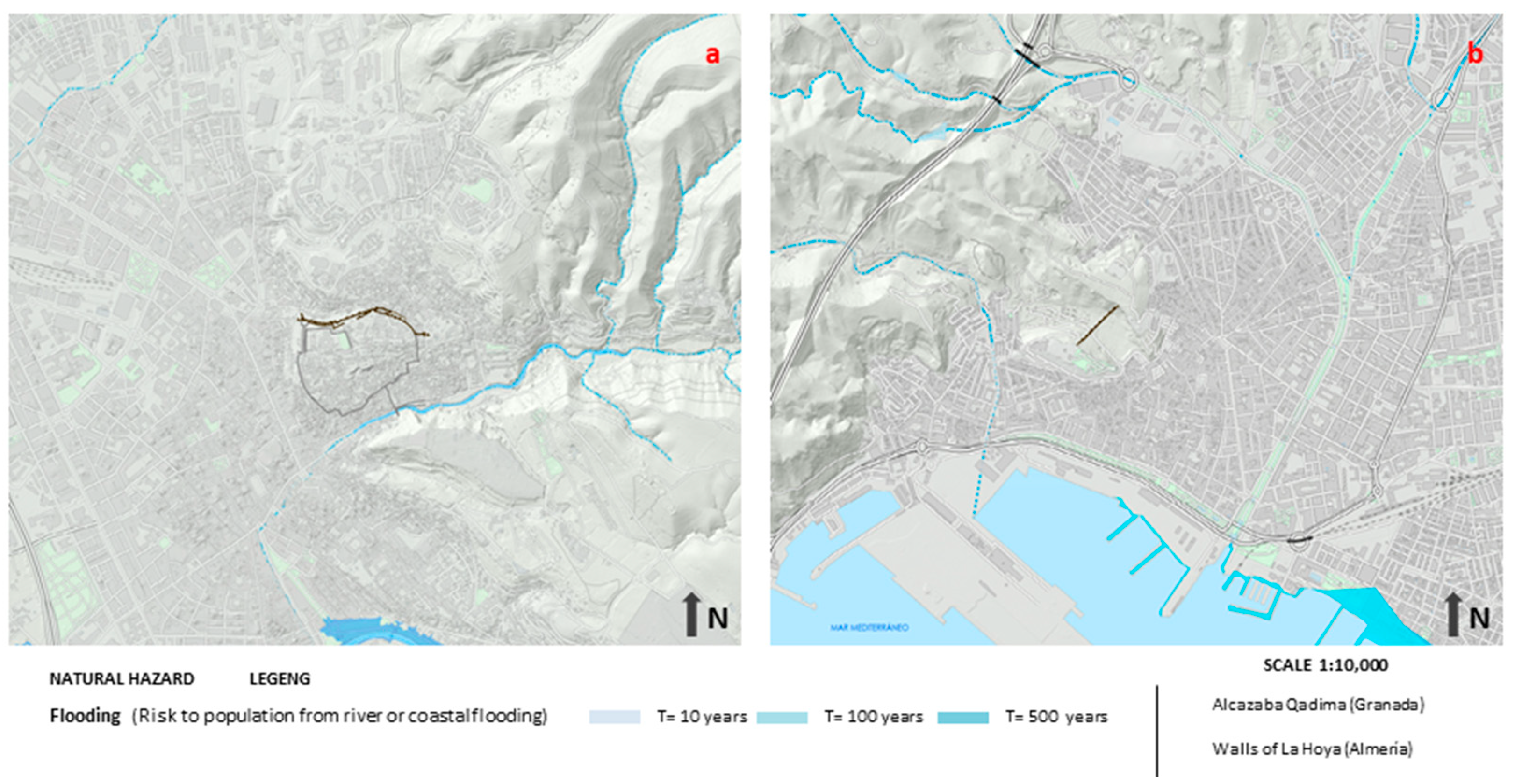
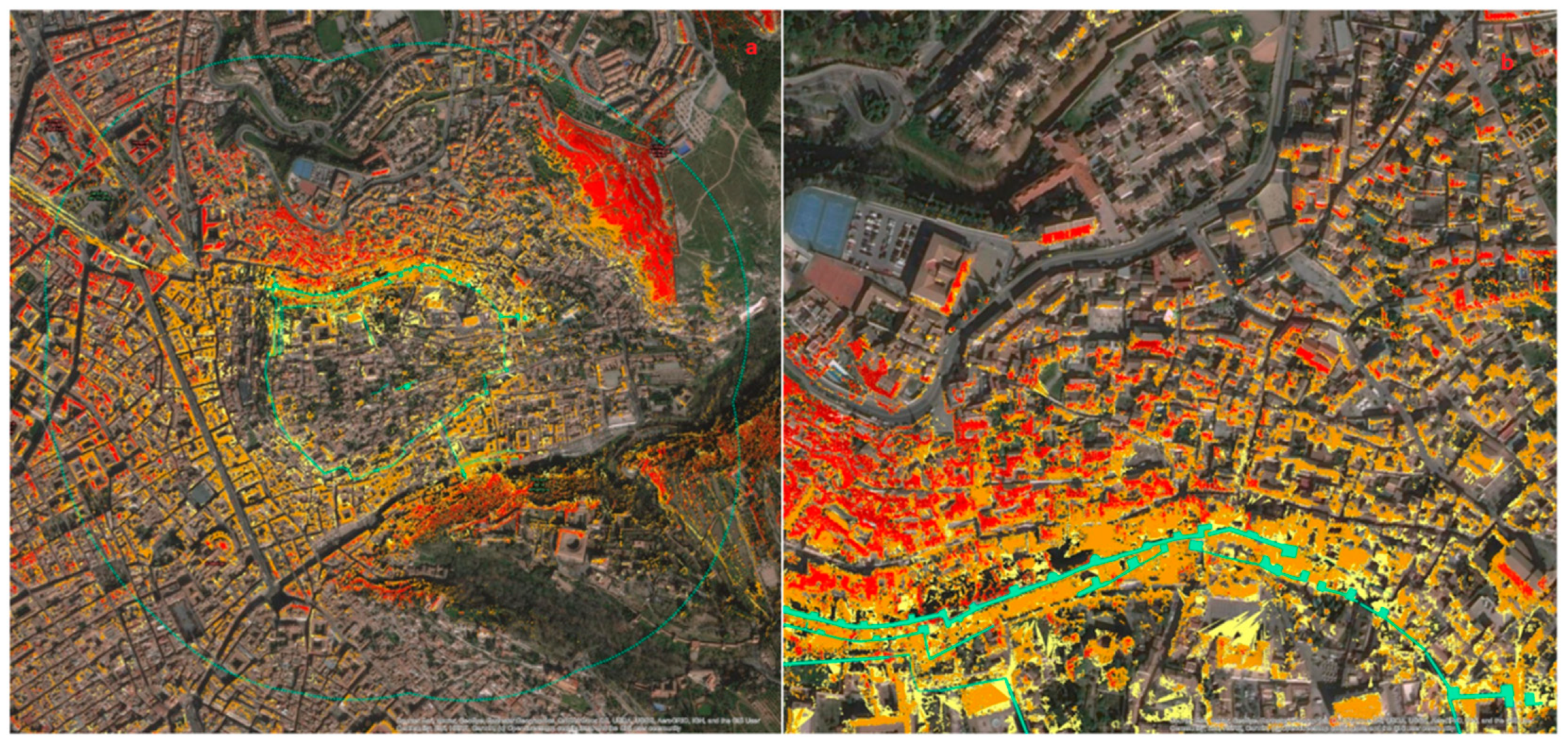
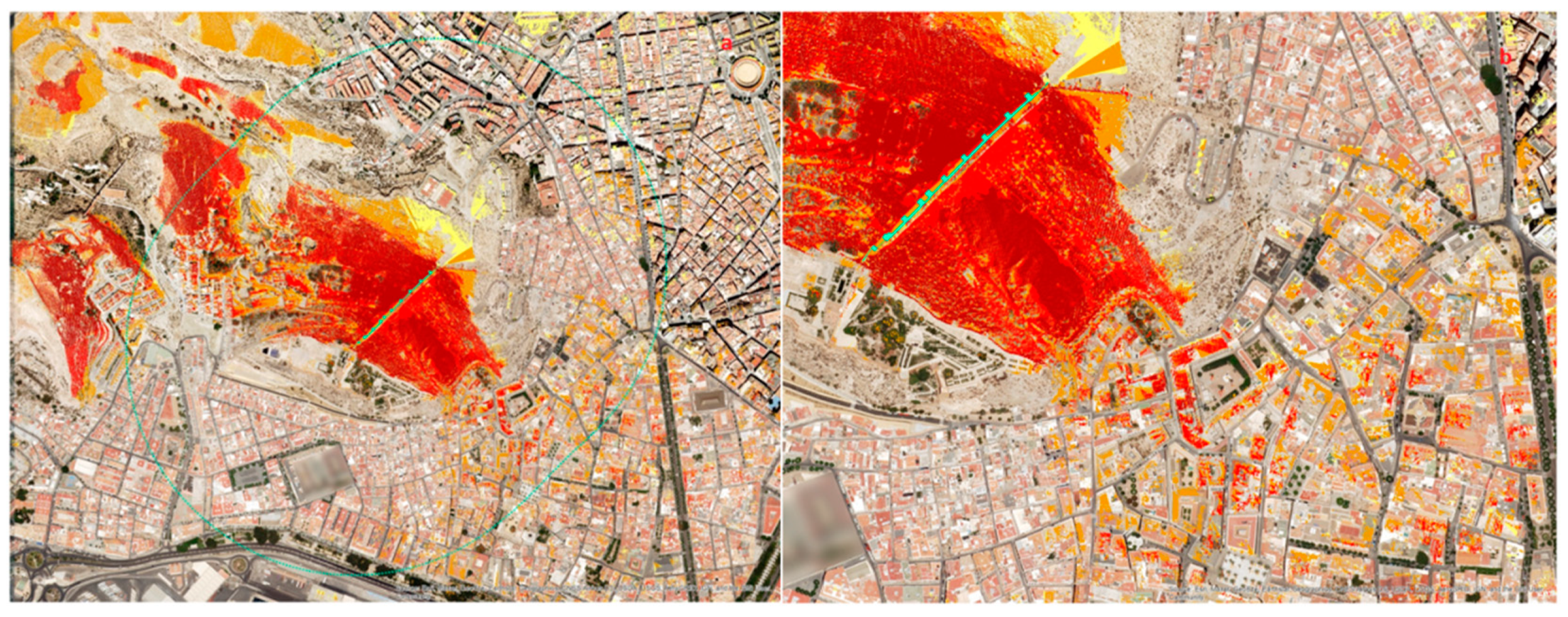
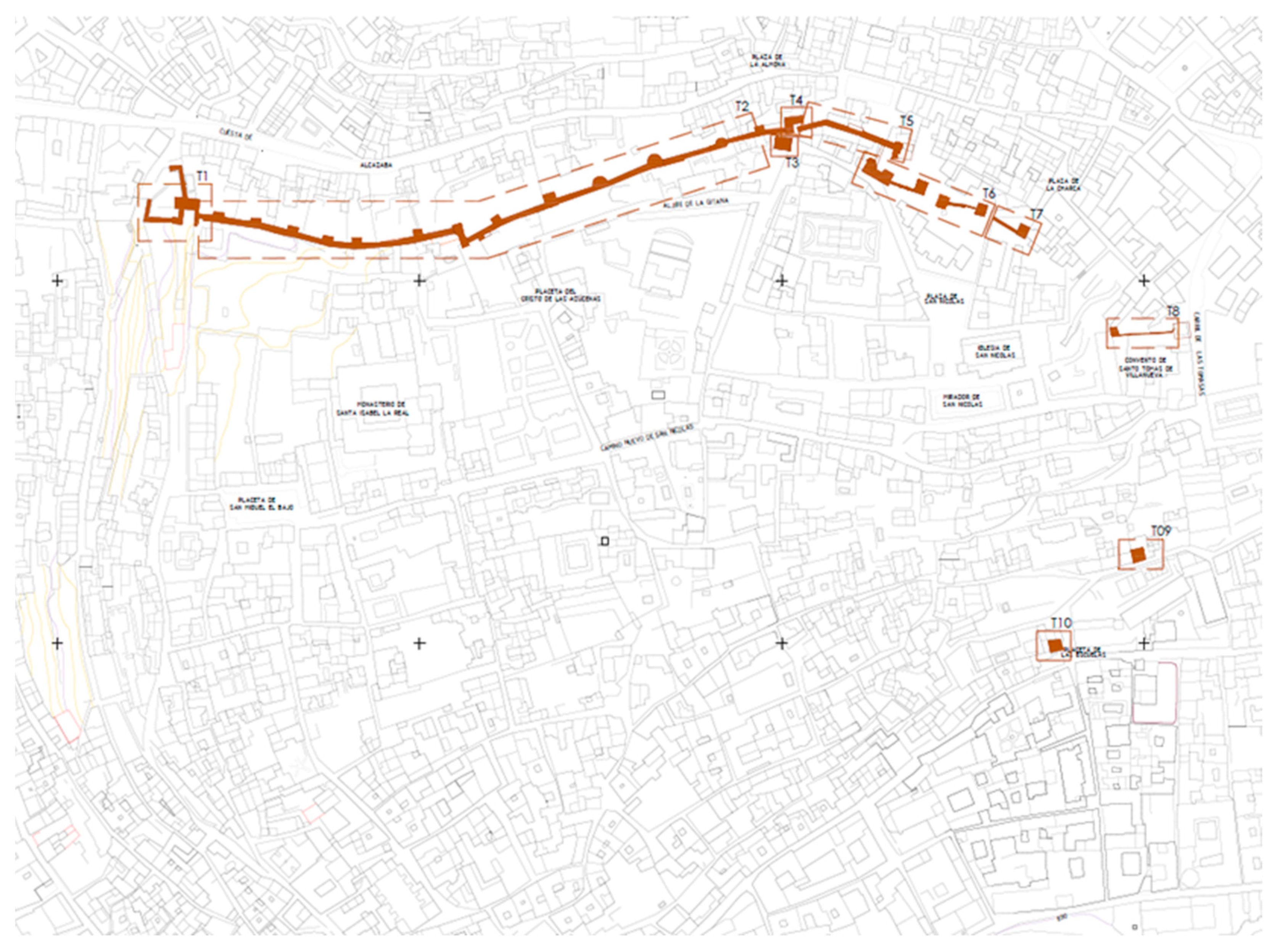
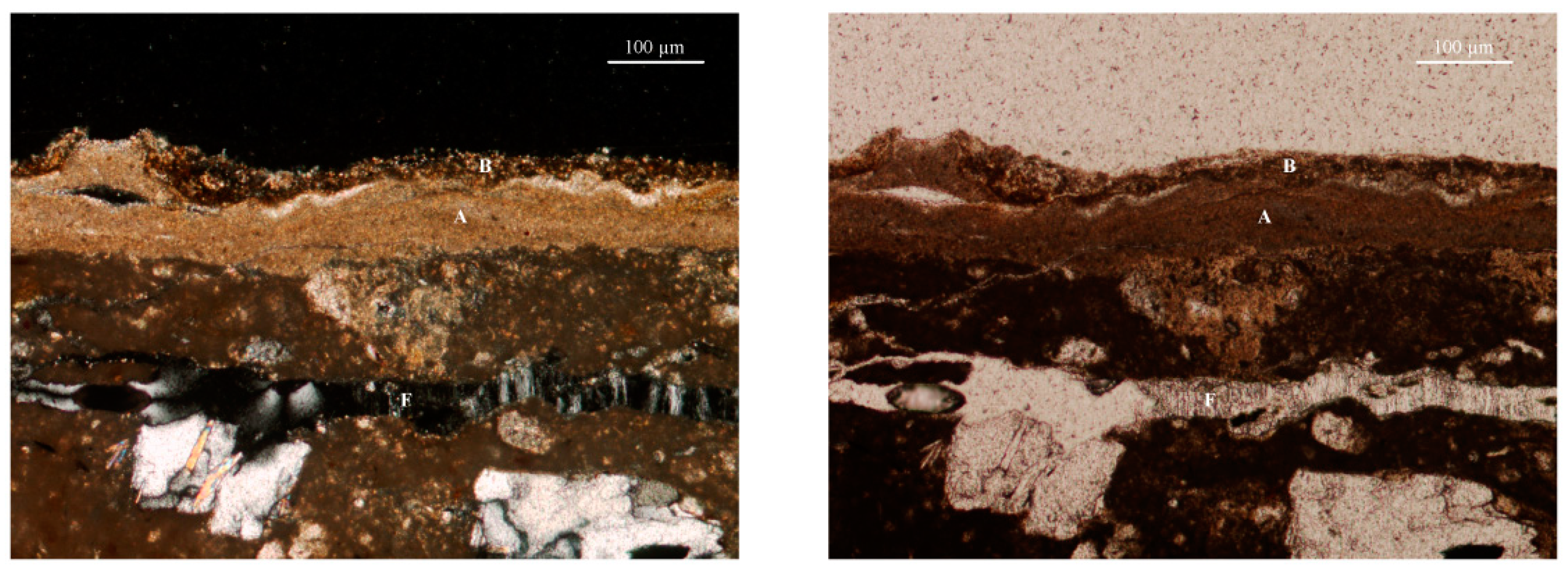

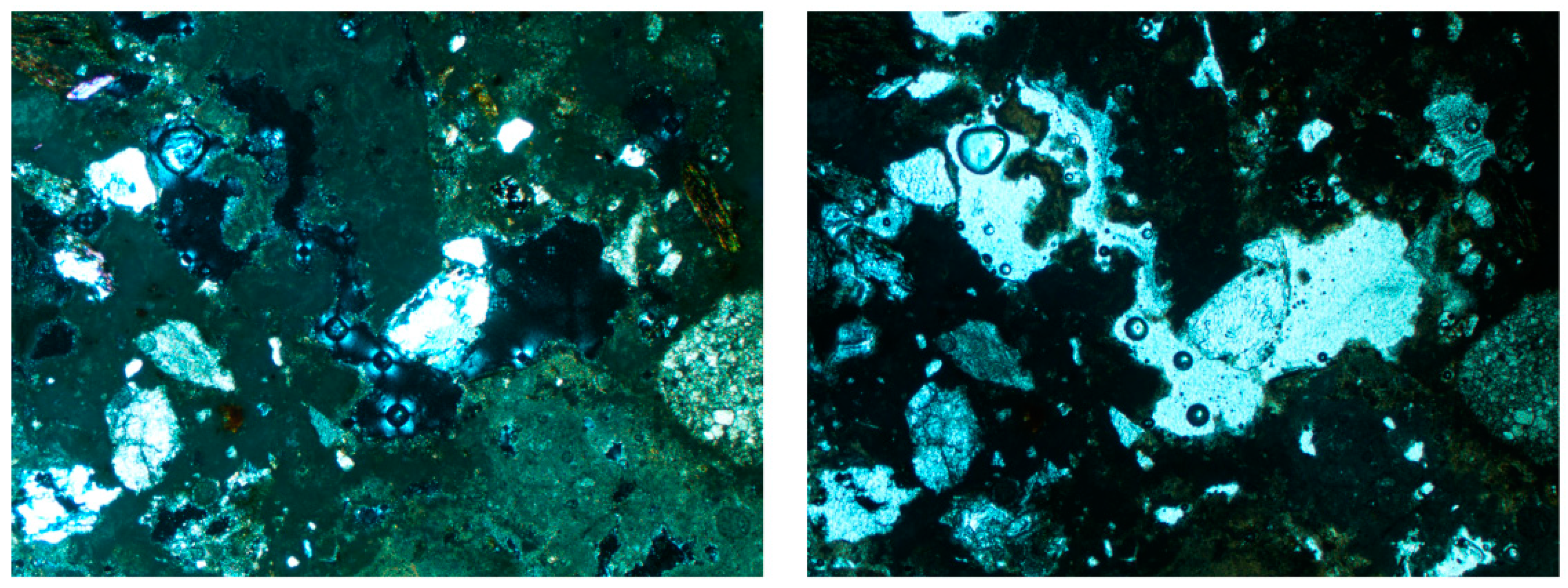




| Name | Location | Chronology | Works on the First Half of the 12th Century | Types of Historical Rammed Earth | Risks of Conservation | |
|---|---|---|---|---|---|---|
| Anthropic | Natural | |||||
| Walls of the Alcazaba Qadīma | Granada | Zīrī (11th century) Almoravids (first half of the 12th century) | Reparations in the walls and towers | Rammed earth with pebble aggregates joined together with mortar Rammed earth with limestone mortar Lime-stabilized rammed earth with less lime inside and resistant lime mortar outside | Urban pressure Abandonment Vandalism and graffiti | Thermal oscillations Dampness due to filtered water Dampness due to capillarity Rainwater Vegetation on the wall Earthquakes Landslides |
| Alcazaba of Guadix | Guadix (Granada) | Zīrī (11th century) Almoravids/2nd Taifas (12th century) Nasrids (13th–15th century) | Barbican | Lime-stabilized rammed earth with less lime inside and resistant lime mortar outside Rammed earth with stone and lime mortar cement | Occupation as a military quarter during the War of Independence Repairs using poor quality materials and contemporary materials (Portland cement concrete and mixed concrete made of soil and cement) Use as a cemetery of the interior esplanade Bombings during the Civil War Graffiti Sports facilities in the interior enclosure Urban pressure | Environmental factors Vegetation on the walls |
| Walls of La Hoya and Cerro de San Cristóbal | Almeria | Zīrī (11th century) Almoravids (first half of the 12th century) Christians (1147) Almohads (from 1157) | Reparations in the walls | High hardness lime-stabilized rammed earth | Urban pressure Graffiti Garbage and debris Use of corten steel in a recent restoration | Earthquakes Dampness due to filtered water Rainwater Wind Thermal oscillations Small plants, mosses and fungi in the upper part of the walls Detritus |
| Urban walls of Almeria | Almeria | Caliphal (10th century) Zīrī (11th century) Almoravids (first half of the 12th century) | Reparations in the walls and towers | Rammed earth of coastal sand Mortar and compact earth Mortar and small stones Ashlar combined with mortar Bricks combined with compact earth and mortar | Urban pressure Abandonment Artillery of the Anglo-Dutch attacks of 1703 | Earthquakes |
| El Castillejo | Abrucena (Almeria) | Almoravids (first half of the 12th century) Almohads (12th–13th centuries) | Original construction repaired in the Almohad period | Rammed earth with stone and lime mortar cement on a masonry base Lime-stabilized rammed earth | Urban pressure Abandonment Agricultural activity Use of the cistern as livestock refuge Vandalism and paintings | Surface erosion Clay patina Presence of mosses, fungi and lichens Water saturation Thermal oscillations Dampness due to filtered water Detritus |
| Castle of Bacares | Bacares (Almeria) | Almoravids (first half of the 12th century) Nasrids (13th century) | Original construction transformed in the Nasrid period | Lime-stabilized rammed earth on a masonry base | Abandonment Graffiti | Rainwater Dampness due to filtered water Presence of mosses, fungi and low vegetation |
Publisher’s Note: MDPI stays neutral with regard to jurisdictional claims in published maps and institutional affiliations. |
© 2021 by the authors. Licensee MDPI, Basel, Switzerland. This article is an open access article distributed under the terms and conditions of the Creative Commons Attribution (CC BY) license (https://creativecommons.org/licenses/by/4.0/).
Share and Cite
Marcos Cobaleda, M.; Gutiérrez-Carrillo, M.L. Almoravid Works on Defensive Architecture in Southeast Al-Andalus: Analysis of Their Remains and Proposal for Preventive Conservation. Sustainability 2021, 13, 13597. https://doi.org/10.3390/su132413597
Marcos Cobaleda M, Gutiérrez-Carrillo ML. Almoravid Works on Defensive Architecture in Southeast Al-Andalus: Analysis of Their Remains and Proposal for Preventive Conservation. Sustainability. 2021; 13(24):13597. https://doi.org/10.3390/su132413597
Chicago/Turabian StyleMarcos Cobaleda, María, and Mª Lourdes Gutiérrez-Carrillo. 2021. "Almoravid Works on Defensive Architecture in Southeast Al-Andalus: Analysis of Their Remains and Proposal for Preventive Conservation" Sustainability 13, no. 24: 13597. https://doi.org/10.3390/su132413597
APA StyleMarcos Cobaleda, M., & Gutiérrez-Carrillo, M. L. (2021). Almoravid Works on Defensive Architecture in Southeast Al-Andalus: Analysis of Their Remains and Proposal for Preventive Conservation. Sustainability, 13(24), 13597. https://doi.org/10.3390/su132413597







